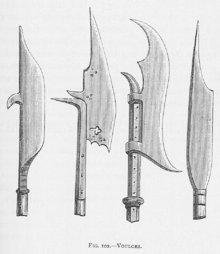Voulge

A voulge (occasionally called a pole cleaver) is a type of polearm that existed alongside the similar glaive in medieval Europe. [1] Superficially, a voulge might strongly resemble a glaive, but there are some notable differences in construction. [2] First, the attachment of the voulge blade to the shaft was usually done by binding the lower two thirds of the blade to the side of the pole; the glaive would often have a socket built into the blade itself and was mounted on top of the pole. In addition, while both had curved blades, that of the voulge was broad and meant for hacking, while that of the glaive was narrow and meant more for cutting. A voulge thus looks something like a squashed bardiche, or just a meat cleaver attached to a long pole.
In early designs it consisted solely of a cutting edge, but in time voulges often had a 'pointed-top' blade for stabbing. Hooks were also incorporated onto the back of the blade, in which case they are referred to as "voulge-guisarmes".
The voulge was commonly used by the French. The Hundred Years War provided many opportunities to prove its utility. It is commonly believed that this was the base design used in the creation of the bayonet, also credited to the French.
References
- ↑ "Medieval polearm weapons - Voulge". Arthur's Armoury.
- ↑ "Voulge - Polearm". Military Factory. Retrieved 28 October 2014.